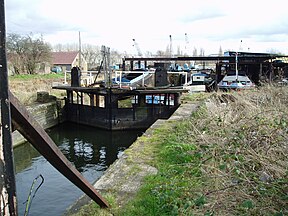| Dearne and Dove Canal | |
|---|---|
 The bottom gate of the third lock in 2008, with Waddington's yard occupying the line of the canal beyond | |
| Specifications | |
| Maximum boat length | 58 ft 0 in (17.68 m) |
| Maximum boat beam | 14 ft 10 in (4.52 m) |
| Locks | 25 |
| Status | Restoration proposed, part new route |
| History | |
| Original owner | Dearne and Dove Canal Company |
| Principal engineer | Robert Mylne |
| Other engineer(s) | John Thompson |
| Date of act | 1793 |
| Date completed | 1804 |
| Date closed | 1961 |
| Geography | |
| Start point | Barnsley 53°33′25″N 1°27′50″W / 53.5569°N 1.4640°W |
| End point | Swinton 53°29′04″N 1°18′10″W / 53.4845°N 1.3028°W |
| Branch(es) | Elsecar, Worsborough |
| Connects to | River Don Navigation, Barnsley Canal |
Dearne and Dove Canal | |||||||||||||||||||||||||||||||||||||||||||||||||||||||||||||||||||||||||||||||||||||||||||||||||||||||||||||||||||||||||||||||||||||||||||||||||||||||||||||||||||||||||||||||||||||||||||||||||||||||||||||||||||||||||||||||||||||||||||||||||||||||||||||||||||||||||||||||||||||||||||||||
|---|---|---|---|---|---|---|---|---|---|---|---|---|---|---|---|---|---|---|---|---|---|---|---|---|---|---|---|---|---|---|---|---|---|---|---|---|---|---|---|---|---|---|---|---|---|---|---|---|---|---|---|---|---|---|---|---|---|---|---|---|---|---|---|---|---|---|---|---|---|---|---|---|---|---|---|---|---|---|---|---|---|---|---|---|---|---|---|---|---|---|---|---|---|---|---|---|---|---|---|---|---|---|---|---|---|---|---|---|---|---|---|---|---|---|---|---|---|---|---|---|---|---|---|---|---|---|---|---|---|---|---|---|---|---|---|---|---|---|---|---|---|---|---|---|---|---|---|---|---|---|---|---|---|---|---|---|---|---|---|---|---|---|---|---|---|---|---|---|---|---|---|---|---|---|---|---|---|---|---|---|---|---|---|---|---|---|---|---|---|---|---|---|---|---|---|---|---|---|---|---|---|---|---|---|---|---|---|---|---|---|---|---|---|---|---|---|---|---|---|---|---|---|---|---|---|---|---|---|---|---|---|---|---|---|---|---|---|---|---|---|---|---|---|---|---|---|---|---|---|---|---|---|---|---|---|---|---|---|---|---|---|---|---|---|---|---|---|---|---|---|---|---|---|---|---|---|---|---|---|---|---|---|---|---|---|---|---|
| |||||||||||||||||||||||||||||||||||||||||||||||||||||||||||||||||||||||||||||||||||||||||||||||||||||||||||||||||||||||||||||||||||||||||||||||||||||||||||||||||||||||||||||||||||||||||||||||||||||||||||||||||||||||||||||||||||||||||||||||||||||||||||||||||||||||||||||||||||||||||||||||
The Dearne and Dove Canal ran for almost ten miles through South Yorkshire, England from Swinton to Barnsley through nineteen locks, rising 127 feet (39 m). The canal also had two short branches, the Worsbrough branch and the Elsecar branch, both about two miles long with reservoirs at the head of each. The Elsecar branch also has another six locks. The only tunnel was bypassed by a cutting in 1840.[1]
The canal was created mainly to carry cargo from the extensive coal mining industry in the area. Other cargo included pig iron, glass, lime, oil products and general merchandise. A combination of railway competition and subsidence caused by the same mines it served forced the canal into a gradual decline, closing completely in 1961. As the local coal industry also collapsed in the 1980s the canal was thrown a lifeline with the forming of the Barnsley Canal Group who are now attempting to restore the whole canal, an effort further boosted by the abandonment of the railway which replaced it.